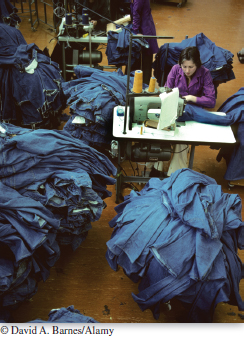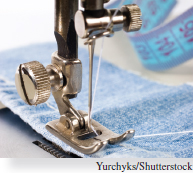CHAPTER 7
Capacity and Facilities Design

LEARNING OBJECTIVES
 AFTER READING THIS CHAPTER, YOU WILL BE ABLE TO:
AFTER READING THIS CHAPTER, YOU WILL BE ABLE TO:
- Evaluate different strategies for capacity expansion.
- Explain the concepts of economies of scale, best operating level, and capacity cushion.
- Describe the advantages and disadvantages of different types of layouts in both manufacturing and service settings.
- Visualize work flow and utilize algorithmic problem solving to lay out a facility.
- Create and evaluate hybrid layouts and hybrid solutions to problems.
CUT 'N SEW JEAN SHOPS
In cut and sew factories, the various components of a pair of jeans are cut from denim material in the cutting room and then “bundled” together to be distributed to individual sewers in the sewing room. The sewers untie the bundle, perform their task, then rebundle it to be passed on to the next process. This is called a progressive bundling system (PBS).
Since most sewers are paid on a piece-rate system (i.e., by how many pieces they can sew in a day) regardless of the production of subsequent sewers, considerable work-in-process (WIP) can build up, as shown in the photo above. It is also true that once the fabric is spread on the cutting table, as many pairs of jeans as possible are cut and bundled for distribution. Thus, on any given day, ...
Get Operations and Supply Chain Management, 8th Edition now with the O’Reilly learning platform.
O’Reilly members experience books, live events, courses curated by job role, and more from O’Reilly and nearly 200 top publishers.

